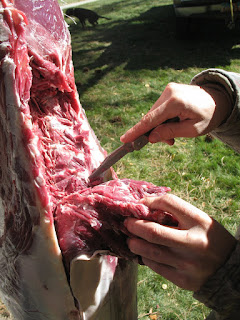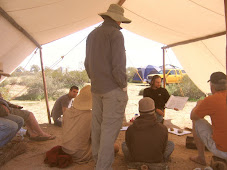So I was glad to receive a phone call and hear that my friends, Danny and Gretchen, were safe and sound after hitting and killing a two-point mule deer buck near the town cemetery. I was also quite excited to hear that they intended to call the game warden and take th e deer home with them to butcher -- and that they needed my help to load the animal into their pick-up truck. "We'll give you some of the meat, if you're interested," Gretchen said. Hmm. Fresh venison, bones for soup, maybe some liver -- sounds good to me!
e deer home with them to butcher -- and that they needed my help to load the animal into their pick-up truck. "We'll give you some of the meat, if you're interested," Gretchen said. Hmm. Fresh venison, bones for soup, maybe some liver -- sounds good to me!
 e deer home with them to butcher -- and that they needed my help to load the animal into their pick-up truck. "We'll give you some of the meat, if you're interested," Gretchen said. Hmm. Fresh venison, bones for soup, maybe some liver -- sounds good to me!
e deer home with them to butcher -- and that they needed my help to load the animal into their pick-up truck. "We'll give you some of the meat, if you're interested," Gretchen said. Hmm. Fresh venison, bones for soup, maybe some liver -- sounds good to me! So off I went with my girlfriend at 9:30 p.m. to do a little "gathering." I can't really say that there was any hunting involved, as all we did was pick up a very dead deer. After loading it into Gretchen and Danny's truck, we agreed to meet up the next day to butcher.
On a beautiful Sunday afternoon in the front yard of a friends house, we began the fascinating process that human beings have engaged in for hundreds of thousands of years before us -- except we used modern technology to get the job done quicker. Danny tied one end of a rope to the hitch of his pick-up truck and the other end over a sturdy tree branch and around the buck's neck, almost like a noose readied for a hanging. Hopping in his truck and pulling forward, the 200+ lbs. animal magically rose into the air and was suspended at the perfect butchering height. Now that's country.

Danny then quickly and efficiently removed the hide of the deer by pulling it back and cutting the fine, sheath-like material just underneath. Once it was freed, Gretchen decided to work the hide and prepare it for tanning. Next, Danny hacksawed off the legs above the knee joints and began quartering the animal, procuring all the choice cuts: brisket, loins, backstrap, and plenty of meat for roasts. He had already thrown out the liver, heart, and other organ meats as they were all damaged and bloody. This particular buck was fairly lean, which makes sense given that it was a lower elevation-dwelling mule deer in October. Deer and elk in higher elevations would certainly be fatter this time of year as they pile on extra stores for the cold winter months.
Danny explained that much of the meat on the buck was questionable for human consumption due to the prevalence of CWD -- Chronic Wasting Disease -- in Utah deer populations. The risk of transmission of this prion disease (similar to the infamous "mad cow disease") to humans is thought to be very low, if at all. But we weren't willing to take the risk, so any meat stained with blood from the spine was discarded (CWD is a central nervous system disease). And we sure weren't about to eat deer brains either, so the head was also tossed.
In the end, after quartering and butchering the buck, we attained 70-80 lbs. of roasts, steaks, and tough meat for burger grind. My friend at the local meat locker was kind enough to blend the grind meat with some grass-fed beef fat he had on hand, which made for some amazing hamburgers. We also hacked up the bones, rich with marrow, for broth and soup.
Total processing costs: $17. Estimated damage to Danny and Gretchen's vehicle: $400.
 Roadkill Mule Deer: $417. A true country delicacy.
Roadkill Mule Deer: $417. A true country delicacy.


